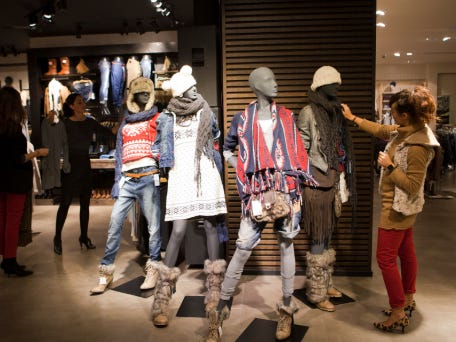Ep. 9: Thrifting is THE Shit
The resale and secondhand clothing market, led by platforms like ThredUp and Depop, is skyrocketing. If you have teenagers in your family, you probably have heard the all-too-often request to go “thrifting.” Let’s learn some shit about this growing industry.
First some context... So-called “fast fashion” has been the biggest trend in the fashion industry over the last 20 years, heralded by international brands like Zara, H&M and Shein.

Fast fashion is remarkably responsive to consumer tastes. Low-cost, high volume production lines are driven by automation, digital design and smart factories to be able to take an article of clothing from idea to store shelves in weeks. However, fast fashion has a dark underbelly: the rapid pace of buying and discarding clothing that has produced literal mountains of wasted, overstock clothing.

In that context, consumers are embracing sustainability with a chic twist: thrifting, flipping, and reselling. By 2028, this sector is projected to hit a whopping $77 billion, growing faster than any other segment of the fashion industry.
Whether you’re scrolling Depop in your PJs or treasure hunting at Goodwill, secondhand shopping is the undisputed eco-chic queen of modern retail. But not all thrifting is created equal. The rise of online resale platforms like ThredUp and Depop has turned thrifting into a sleek, digital hustle, while old-school brick-and-mortar thrift stores soldier on, serving communities and rescuing clothes from landfill doom.
Let’s unbox this trend and see what’s inside the seams…

Resale is booming at the convergence of a number of waves. Younger generations, especially Gen Z and Millennials, are driving the shift. Over 40% of Gen Z prefer buying secondhand over new, and 62% of all shoppers say they’d rather buy sustainable brands when possible.
The lure of finding high-end labels for pennies on the dollar also increases the appeal of resale. Resale platforms offer the allure of designer brands minus the buyer’s remorse. At the same time, the rise of “Y2K fashion” and vintage aesthetics has turned secondhand shopping into a treasure hunt for nostalgia gold. And all of these trends are amplified with digital ecommerce technology that makes used-clothing inventory from all around the world available in every dorm room.

Two of the major players in online resale are ThredUp and Depop. They were both founded within the last 15 years in cities that have strong presences in both the fashion and technology worlds (ThredUp in 2009, San Francisco, and Depop in 2011, London).
ThredUp is known as the largest online thrift store, processing over 100,000 items daily. The company has major retail partners like Walmart and Gap who integrate resale into their mainstream clothing commerce experiences. ThredUp operates as a consignment-style marketplace that makes it easy for sellers to mail in items to photograph, list, and sell. The platform takes a cut and handles logistics. ThredUp went public in 2021, and as of 2023, it boasts a market cap of $500+ million.
Depop is a peer-to-peer marketplace of over 30 million users, mostly in the UK, Europe and North America. 90% of them are under 26, making it a Gen Z darling. Young, trendy sellers flip unique and vintage items on the Depop marketplace. Popular creators lead marketing campaigns on the platform. It’s like Instagram for thrift shopping and it’s also a big business. Depop was acquired by Etsy in 2021 for a cool $1.6 billion.

These aren’t the only buying options, of course. Other leading online resale venues include:
Poshmark: A hybrid of Depop and eBay, focusing on mid-to-high-end brands.
RealReal and Vestiare Collective: Dominating the luxury resale market with authenticated items from brands like Chanel and Gucci. RealReal alone earned $700 million in 2023.
Vinted: Europe’s secondhand powerhouse, with a focus on everyday affordability.
These platforms are collectively redefining what it means to shop sustainably, pulling millions of buyers away from traditional retail. The global secondhand clothing market is growing at a CAGR of 15-20%, outpacing fast fashion and traditional retail. By 2028, it’s expected to hit $77 billion globally, up from $35 billion in 2023.
Big-box stores aren’t just sitting on the sidelines of this movement. Many are integrating secondhand options. Patagonia, for example, launched its Worn Wear program, and brands like Levi’s offer discounts for customers who trade in old items for store credit.

And, of course, the most traditional thrifting outlets are continuing to operate and contribute to the trend as well. Most local thrift stores are operated by nonprofits, funneling revenues into community programs. Goodwill, one of the largest, generates around $5.5 billion revenues annually, but a big chunk of that supports its workforce training and job placement programs. While thrift stores might operate on thinner margins and therefore not have Silicon Valley valuations, their local impact is priceless.
Over the next few years Resale is likely to continue growing into a dominant force in fashion. Whether through thrifty finds on ThredUp, swiping on Depop, digging through Goodwill racks, or luxury steals from RealReal, the secondhand market is proving that fashion’s future doesn’t need to come at the planet’s expense. And that’s a trend we can all feel good about. ♻️👗💰




